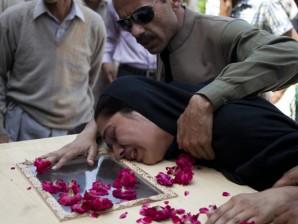
A man comforts a woman who cries over a coffin of her family member who was killed in Friday's passenger plane crash, at a local hospital in Islamabad, Pakistan on Saturday, April 21, 2012. Pakistan blocked the head of an airline whose jet crashed near the capital from leaving the country as it began an investigation Saturday into the country's second major air disaster in less than two years. AP
ISLAMABAD – Distraught relatives wept Saturday as they collected the remains of loved ones after a Pakistani passenger jet crashed in bad weather near Islamabad, killing all 127 people on board.
The Bhoja Air flight from Karachi came down in fields near a village on the outskirts of capital Islamabad at around 6:40 pm on Friday evening (1340 GMT) – the city’s second major fatal air crash in less than two years.
The airline said the Boeing 737 was carrying 121 passengers, including 11 children, as well as six crew.
Civil aviation official Junaid Khan told Agence France-Presse: “All 127 people died. No one survived. There was no possibility of any survivor in this crash.”
Doctor Waseem Khawaja, who is in charge of Islamabad’s main hospital, the Pakistan Institute of Medical Sciences (PIMS), said bodies had been brought in more than 100 bags.
“There was no survivor, all on board are dead,” he told AFP.
The doctor said that despite the fire, most of the bodies were not charred and 73 had been identified already, with 53 handed over to relatives.
Rows of coffins, some sprinkled with rose petals by hospital staff as a gesture of compassion, were lined up in a room with handwritten notes identifying the dead by name, TV images showed.
Police officers and soldiers at the hospital consoled the relatives as many, overwhelmed with emotion, wept uncontrollably on receiving the coffins.
The Boeing 737-200 was 28 years old, a Civil Aviation Authority (CAA) official who asked not to be named told AFP, but Bhoja Air insisted that despite its age, the plane was safe to fly.
“The aircraft was old and second hand but it is not something unusual. The fleet of state-run Pakistan International Airlines (PIA) also runs old aircraft,” Bhoja Air official Masham Zafar told AFP.
“Airlines rarely have brand new planes, and this aircraft was also refurbished.”
She said there was no technical problem with the plane and added that the plane left Karachi with CAA approval and was given clearance to land at Islamabad.
Prime Minister Yousuf Raza Gilani, visiting the hospital, told reporters a judicial commission would investigate the crash, which came less than two years after the worst ever air disaster on Pakistani soil.
In July 2010 an Airbus A321 operated by the private airline Airblue crashed into the hills overlooking Islamabad while coming in to land in heavy rain and poor visibility, killing all 152 people on board.
Boeing offered “profound condolences” to the victims’ families and said it would provide technical assistance to the investigation into the Bhoja crash.
Debris from the crash was scattered over a two-kilometre (one-mile) area, with torn fragments of the fuselage, including a large section bearing the Bhoja Air logo, littering the fields around the village of Hussain Abad.
Military and aviation officials said bad weather was probably behind the crash, as there was a hail and thunderstorm over the city at the time.
A senior PIA engineer told AFP the age of the aircraft mattered less than its flying hours, and said he thought an air pocket – a patch of low air pressure – could be to blame.
“Since it was approaching the airport to land it was obviously flying low — between 3,000 and 4,000 feet above the ground,” he said.
“Visibility was also low because it was raining and there was thunder and lightening. The pilot lost control and apparently failed to lift it out of the air pocket.”
Bhoja Air began domestic operations after Pakistan opened up its skies to private companies in the 1990s and ran international flights as far afield as the United Arab Emirates, before having its licence suspended in 2000 after failing to pay dues to CAA.
It relaunched domestic operations in March, and Friday was its first evening flight from Karachi to Islamabad.
The deadliest civilian plane crash involving a Pakistani jet came in 1992 when a PIA Airbus A300 crashed into a cloud-covered hillside on its approach to the Nepalese capital Kathmandu, killing 167 people.